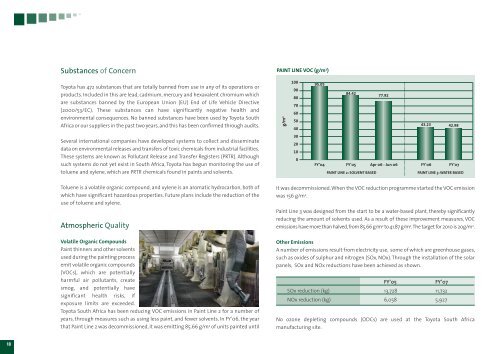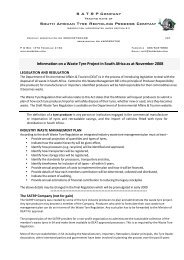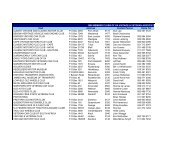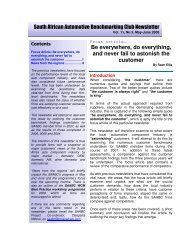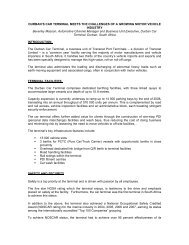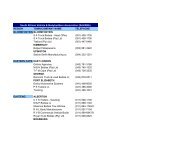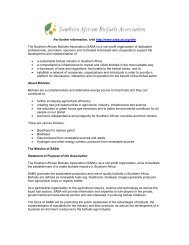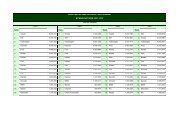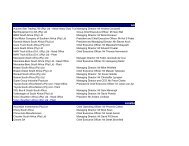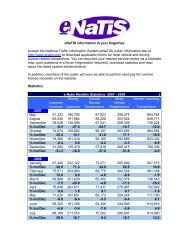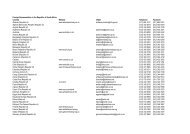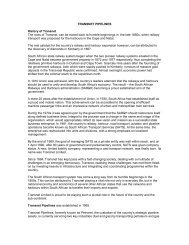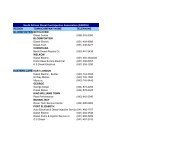Toyota South Africa Sustainability Report 2008 - Automotiveonline ...
Toyota South Africa Sustainability Report 2008 - Automotiveonline ...
Toyota South Africa Sustainability Report 2008 - Automotiveonline ...
Create successful ePaper yourself
Turn your PDF publications into a flip-book with our unique Google optimized e-Paper software.
<strong>Sustainability</strong> <strong>Report</strong>_14-10-<strong>2008</strong>:Layout 1 10/14/08 2:45 PM Page 18<br />
Substances of Concern<br />
PAINT LINE VOC (g/m 2 )<br />
<strong>Toyota</strong> has 472 substances that are totally banned from use in any of its operations or<br />
products. Included in this are lead, cadmium, mercury and hexavalent chromium which<br />
are substances banned by the European Union (EU) End of Life Vehicle Directive<br />
(2000/53/EC). These substances can have significantly negative health and<br />
environmental consequences. No banned substances have been used by <strong>Toyota</strong> <strong>South</strong><br />
<strong>Africa</strong> or our suppliers in the past two years, and this has been confirmed through audits.<br />
g/m 2<br />
100<br />
90<br />
80<br />
70<br />
60<br />
50<br />
40<br />
95.05<br />
84.42<br />
77.92<br />
43.23 42.98<br />
Several international companies have developed systems to collect and disseminate<br />
data on environmental releases and transfers of toxic chemicals from industrial facilities.<br />
These systems are known as Pollutant Release and Transfer Registers (PRTR). Although<br />
such systems do not yet exist in <strong>South</strong> <strong>Africa</strong>, <strong>Toyota</strong> has begun monitoring the use of<br />
toluene and xylene, which are PRTR chemicals found in paints and solvents.<br />
30<br />
20<br />
10<br />
0<br />
FY’04 FY’05 Apr 06 - Jun 06 FY’06 FY’07<br />
PAINT LINE 2: SOLVENT BASED<br />
PAINT LINE 3: WATER BASED<br />
Toluene is a volatile organic compound, and xylene is an aromatic hydrocarbon, both of<br />
which have significant hazardous properties. Future plans include the reduction of the<br />
use of toluene and xylene.<br />
Atmospheric Quality<br />
it was decommissioned.When the VOC reduction programme started the VOC emission<br />
was 156 g/m 2 .<br />
Paint Line 3 was designed from the start to be a water-based plant, thereby significantly<br />
reducing the amount of solvents used. As a result of these improvement measures, VOC<br />
emissions have more than halved,from 85.66 g/m 2 to 41.87 g/m 2 .The target for 2010 is 20g/m 2 .<br />
Volatile Organic Compounds<br />
Paint thinners and other solvents<br />
used during the painting process<br />
emit volatile organic compounds<br />
(VOCs), which are potentially<br />
harmful air pollutants, create<br />
smog, and potentially have<br />
significant health risks, if<br />
exposure limits are exceeded.<br />
<strong>Toyota</strong> <strong>South</strong> <strong>Africa</strong> has been reducing VOC emissions in Paint Line 2 for a number of<br />
years, through measures such as using less paint, and fewer solvents. In FY’06, the year<br />
that Paint Line 2 was decommissioned, it was emitting 85.66 g/m 2 of units painted until<br />
Other Emissions<br />
A number of emissions result from electricity use, some of which are greenhouse gases,<br />
such as oxides of sulphur and nitrogen (SOx, NOx). Through the installation of the solar<br />
panels, SOx and NOx reductions have been achieved as shown.<br />
FY’05<br />
FY’07<br />
SOx reduction (kg) 13,728 11,732<br />
NOx reduction (kg) 6,058 5,927<br />
No ozone depleting compounds (ODCs) are used at the <strong>Toyota</strong> <strong>South</strong> <strong>Africa</strong><br />
manufacturing site.<br />
18


